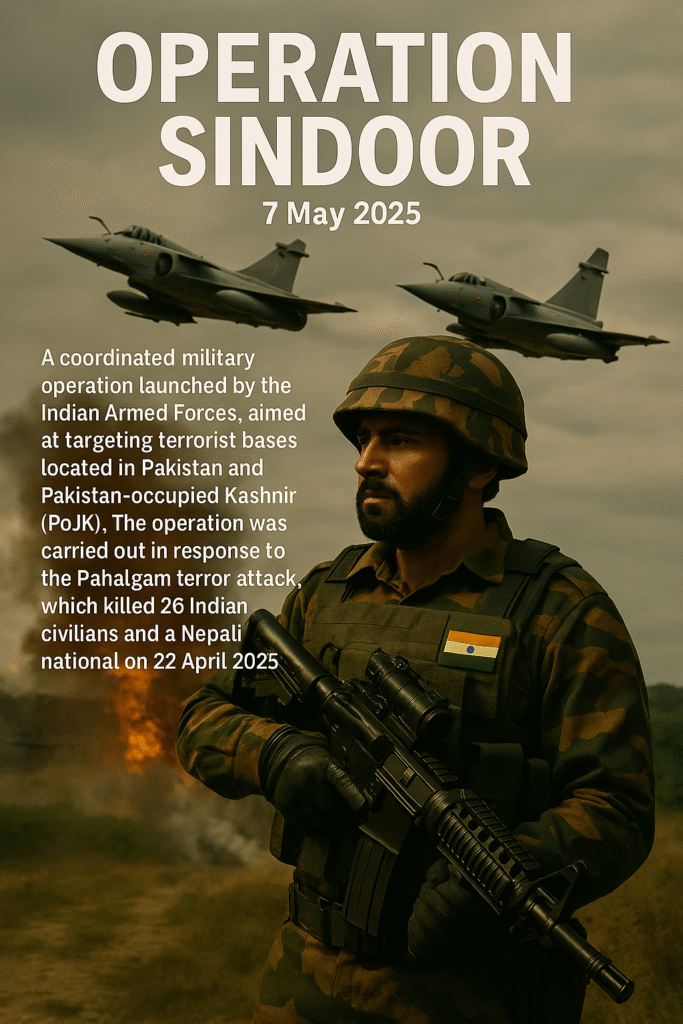
Operation Sindoor was a coordinated military operation launched by the Indian Armed Forces on 7 May 2025, aimed at targeting terrorist bases located in Pakistan and Pakistan-occupied Kashmir (PoJK). The operation was carried out in response to the Pahalgam terror attack, which killed 26 Indian civilians and a Nepali national on 22 April 2025.
Key points of Operation Sindoor:
- Target: Destroying the bases of Jaish-e-Mohammed, Lashkar-e-Taiba and Hizbul Mujahideen.
- Location: Attacks were carried out on 9 terrorist bases in Pakistan and PoJK.
- Weapons used: The Indian Air Force used advanced systems such as SCALP cruise missiles, HAMMER precision-guided bombs and loitering munitions.
- Results: According to India, the operation killed 100+ terrorists, including Jaish-e-Mohammed chief Abdul Rauf Azhar.
Political and strategic impact:
- Pakistan called the attack an act of war and launched retaliatory strikes, in which some Indian Army personnel were killed.
- India described the operation as precise and non-provocative, preventing the escalation of tensions.
- BSF proposed naming two of its posts after the martyred soldiers, giving the operation an emotional and national significance.
The operation was far more extensive than the **2016 surgical strike and the **2019 Balakot airstrike, as it also carried out strikes in Pakistan’s Punjab province.
Major Goals of Operation Sindoor
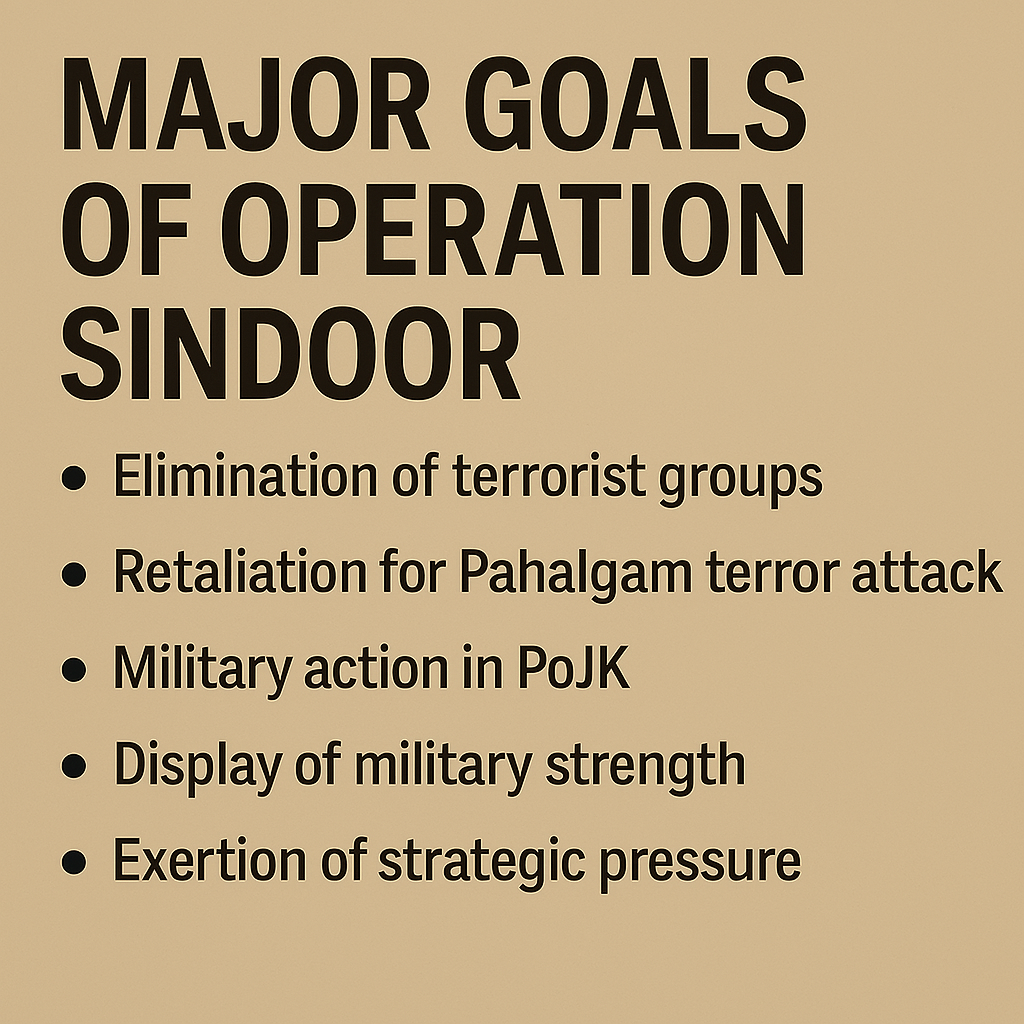
The main goals of Operation Sindoor were as follows:
- Eradication of terrorist organizations – To destroy the major bases of terrorist organizations like Jaish-e-Mohammed, Lashkar-e-Taiba and Hizbul Mujahideen.
- Retaliation for Pahalgam terror attack – To avenge the innocent civilians killed in the Pahalgam attack on 22 April 2025 and to dismantle the terrorist network to prevent such attacks in future.
- Military action in Pakistan-occupied Kashmir (PoJK) – To neutralize terrorist training camps and launch pads located in PoJK, to prevent future infiltration.
- Demonstration of military power – To demonstrate India’s precise military capabilities, thereby strengthening India’s security policy at the international level.
- Creating strategic pressure – To put strategic pressure on Pakistan, so that it reconsiders its policy of supporting terrorism.
- Ensuring national security – To secure India’s international borders and give priority to the safety of citizens.
This operation was one of India’s most precise and comprehensive military actions till date, in which modern weapons and strategic plans were used.
Locations of Operation Sindoor

Under Operation Sindoor, Indian armed forces targeted 9 major terror camps located in Pakistan and Pakistan-occupied Kashmir (PoJK). The locations included were:
- Muridke – Headquarters of Lashkar-e-Taiba.
- Bahawalpur – Major hideout of Jaish-e-Mohammed.
- Kotli – Terrorist training centre.
- Bagh – Area used for launch pads and infiltration.
- Muzaffarabad – Hideout of Hizbul Mujahideen.
- Neelam Valley – Hub of terrorist activities.
- Jhelum Valley – Strategically important area.
- Kirana Hills – Suspected weapon storage site.
- Banihal Pass – Infiltration route.
The operation was multi-domain and highly precise, with attacks also carried out in Pakistan’s Punjab province.
Weapons used in Operation Sindoor
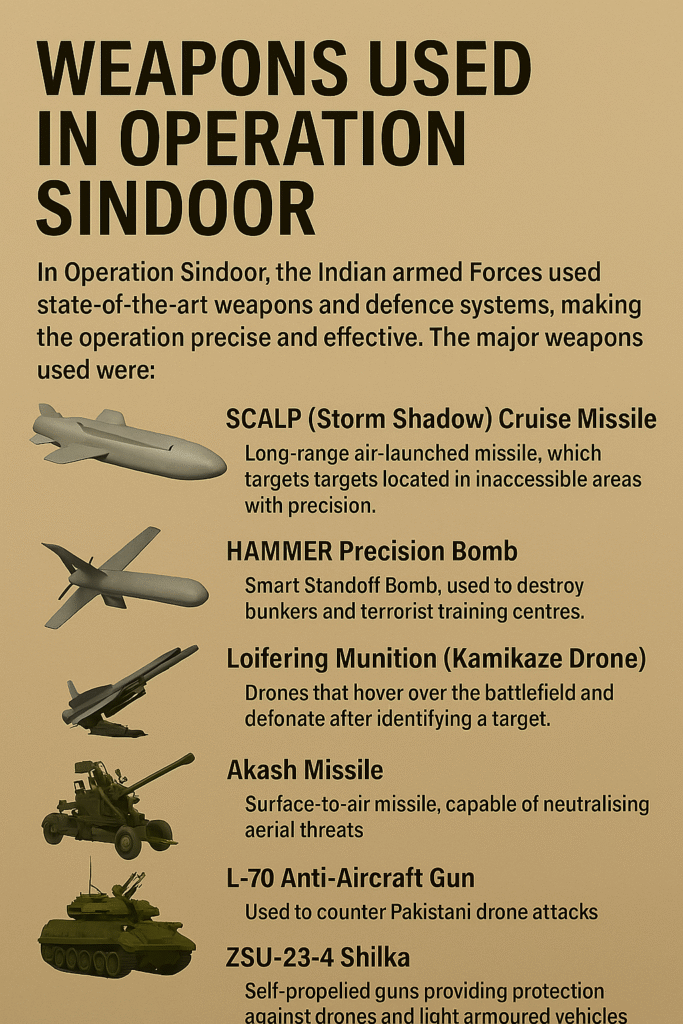
In Operation Sindoor, the Indian armed forces used state-of-the-art weapons and defence systems, making the operation precise and effective. The major weapons used were:
- SCALP (Storm Shadow) Cruise Missile – Long-range air-launched missile, which targets targets located in inaccessible areas with precision.
- HAMMER Precision Bomb – Smart standoff bomb, used to destroy bunkers and terrorist training centres.
- Loitering Munition (Kamikaze Drone) – Drones that hover over the battlefield and detonate after identifying a target.
- Akash Missile – Surface-to-air missile, capable of neutralising aerial threats.
- L-70 Anti-Aircraft Gun – Used to counter Pakistani drone attacks.
- ZSU-23-4 Shilka – Self-propelled guns providing protection against drones and light armoured vehicles.
The use of these weapons provided high accuracy and strategic edge to Operation Sindoor.
Results of Operation Sindoor
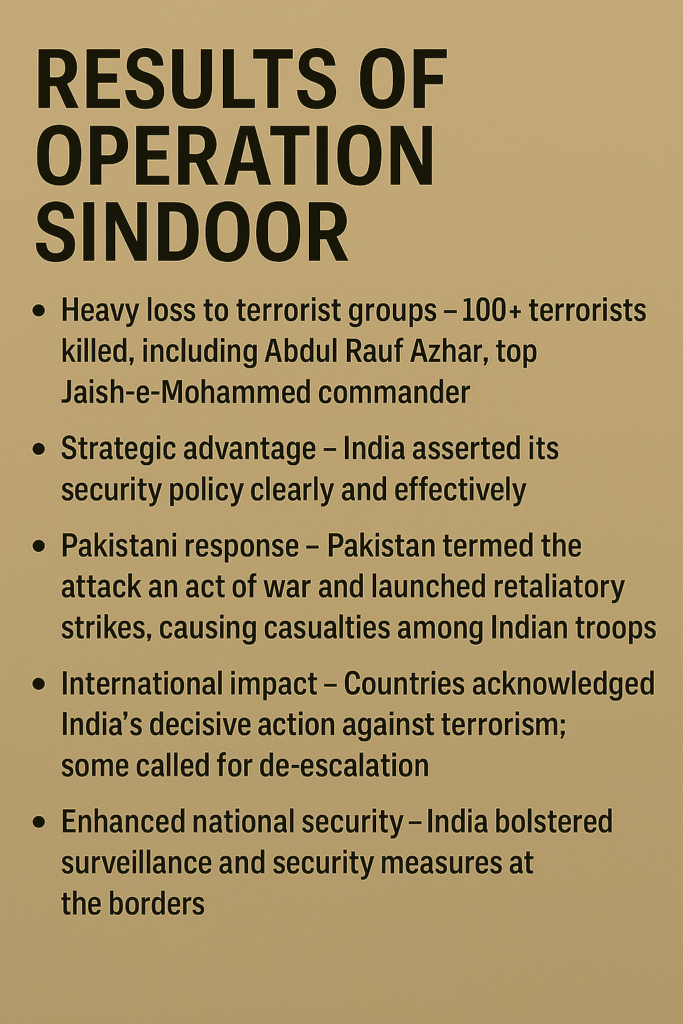
The results of Operation Sindoor were as follows:
- Heavy losses to terrorist organizations – 100+ terrorists were killed in this operation, including Jaish-e-Mohammed chief Abdul Rauf Azhar. Apart from this, many hideouts of Lashkar-e-Taiba and Hizbul Mujahideen were destroyed.
- Strategic advantage – India described this operation as precise and non-provocative, which strengthened India’s security policy internationally.
- Pakistan’s response – Pakistan described this attack as an act of war and retaliated, in which some Indian Army soldiers were martyred.
- International impact – Many countries described India’s move as a decisive action against terrorism, while some countries appealed to reduce tension.
- Improvement in national security – After this operation, the Indian Army further strengthened surveillance and security measures along the border to prevent future infiltration.
This operation was the largest military operation conducted by the Indian Armed Forces after the 1971 war.
Political Effects of Operation Sindoor
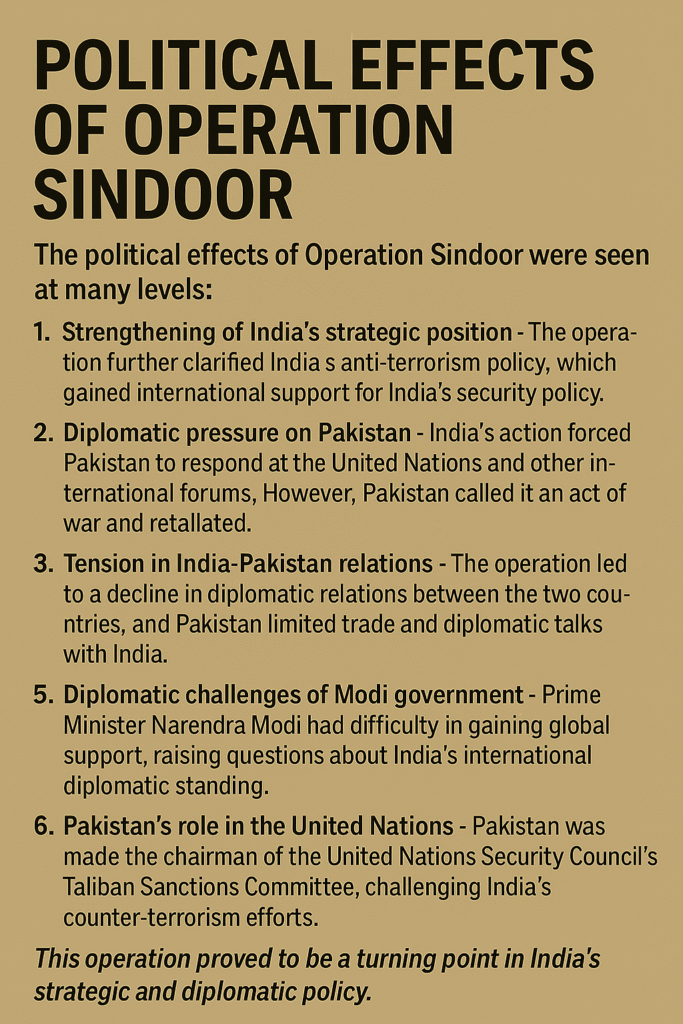
The political effects of Operation Sindoor were seen at many levels:
- Strengthening of India’s strategic position – The operation further clarified India’s anti-terrorism policy, which gained international support for India’s security policy.
- Diplomatic pressure on Pakistan – India’s action forced Pakistan to respond at the United Nations and other international forums. However, Pakistan called it an act of war and retaliated.
- International response – Many countries described India’s move as a decisive action against terrorism, while some countries appealed for de-escalation.
- Tension in India-Pakistan relations – The operation led to a decline in diplomatic relations between the two countries, and Pakistan limited trade and diplomatic talks with India.
- Diplomatic challenges of Modi government – Prime Minister Narendra Modi had difficulty in gaining global support, raising questions about India’s international diplomatic standing.
- Pakistan’s role in the United Nations – Pakistan was made the chairman of the United Nations Security Council’s Taliban Sanctions Committee, challenging India’s counter-terrorism efforts.
This operation proved to be a turning point in India’s strategic and diplomatic policy.
Strategic effects of Operation Sindoor
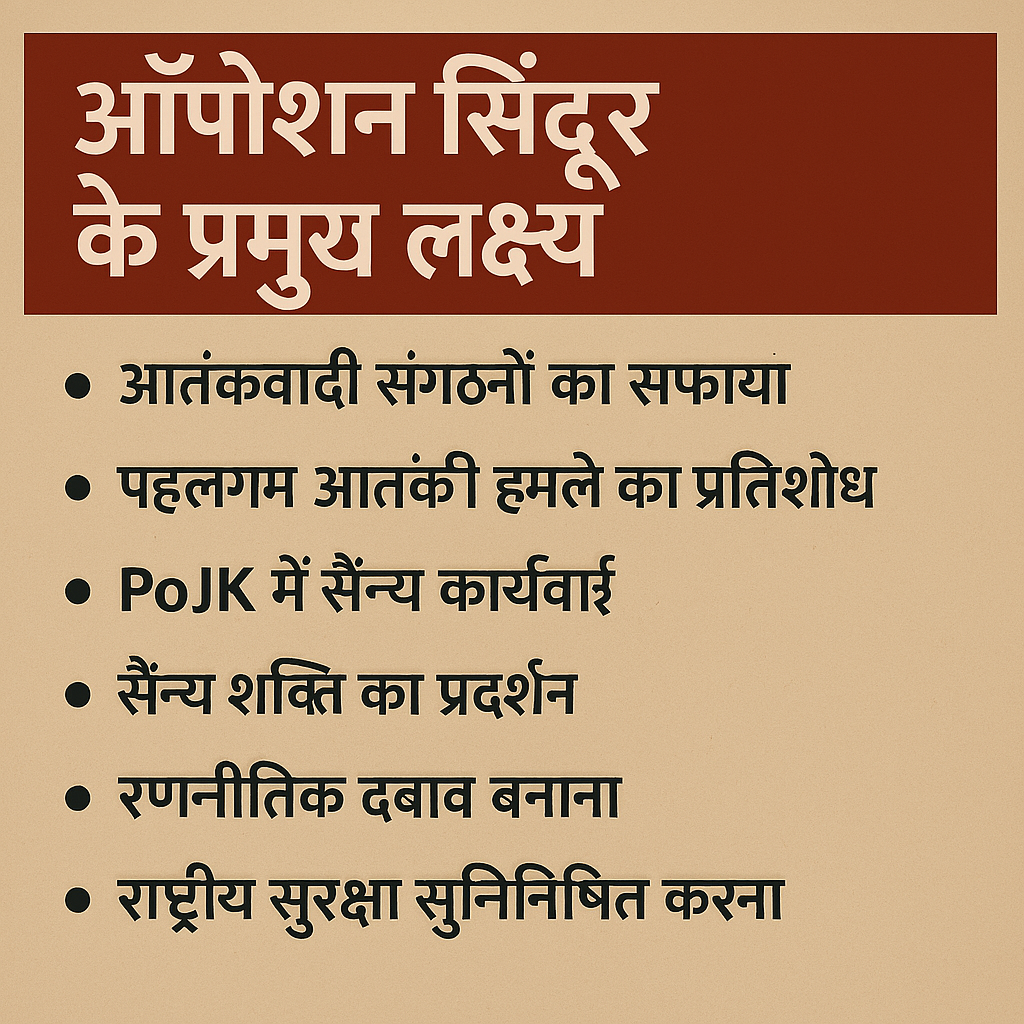
The strategic effects of Operation Sindoor have profound implications for India’s security policy and regional stability. Some of the major effects are as follows:
- Decisive blow to terrorist networks – The operation destroyed the hideouts of Jaish-e-Mohammed, Lashkar-e-Taiba and Hizbul Mujahideen, severely impacting their recruitment and operational capabilities.
- Change in India’s military strategy – The operation was multi-domain and highly precise, with strikes also carried out in Pakistan’s Punjab province. This indicated an aggressiveness in India’s military strategy.
- Improved border security – The Indian Army increased surveillance along the LoC and the international border, which will help prevent infiltration in the future.
- Electronic warfare and cyber security – The operation used drones, satellite surveillance and cyber attacks, proving India’s technological superiority.
- Pakistan’s military response – Pakistan called the attack an act of war and retaliated, increasing military tensions between the two countries.
- India’s international position – India described the operation as precise and non-provocative, gaining support for India’s anti-terrorism policy in the international community.
The operation proved to be a turning point in India’s strategic and military policy.

Very good your subject